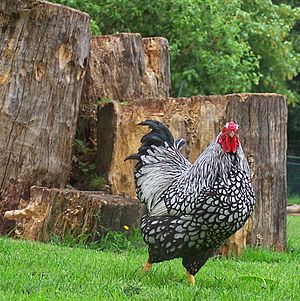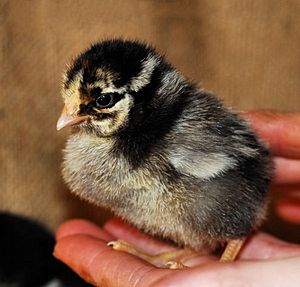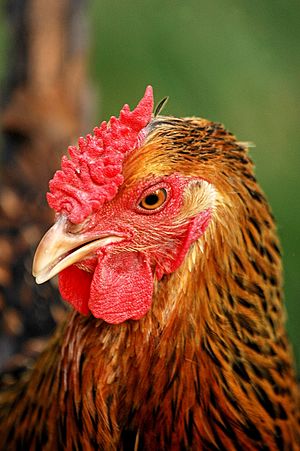Wyandotte chicken facts for kids

The silver-laced is the original variety of the breed.
|
|
| Conservation status | Not at risk |
|---|---|
| Other names | American Sebright (before 1883) |
| Country of origin | United States |
| Use | Dual-purpose |
| Traits | |
| Weight |
|
| Skin color | Yellow |
| Egg color | Brown |
| Comb type | Rose |
| Classification | |
| APA | American |
| EE | yes |
| PCGB | Soft Feather: Heavy |
|
|
The Wyandotte is an American breed of chicken developed in the 1870s. It was named for the indigenous Wyandot people of North America. The Wyandotte is a dual-purpose breed, kept for its brown eggs and its yellow-skinned meat. It is a popular show bird, and has many color variants. It was originally known as the American Sebright.
Contents
History
The Wyandotte was created in the United States in the 1870s by four people, H. M. Doubleday, John Ray, L. Whittaker and Fred Houdlette. The first type was the silver-laced, which was included in the American Standard of Perfection in 1883; it was taken to Britain at about the same time. The origin of the breed is still somewhat a mystery, however silver spangled Hamburgs and dark Brahmas are considered to be important breeds in the initial crosses to developing the Wyandotte. The Hamburg was used for the rose comb and the Brahma for the color pattern. Prior to the breed's acceptance into the Standard of Perfection, the breed was referred to as the “Sebright Cochin” and “American Sebright”. The gold-laced Wyandotte was produced by breeding silver-laced hens with gold-spangled Hamburg and partridge Cochin cocks, the white Wyandotte was a sport of the silver-laced, and the buff variant came from crossing the silver-laced with buff Cochin stock; the black variant was also a sport, of both the silver-laced and the gold-laced. The partridge Wyandotte came from crossing the gold-laced with Indian Game, partridge Cochin, gold-pencilled Hamburghs, and a strain called "Winnebago". The Columbian was the result of a chance crossing of white Wyandottes with barred Plymouth Rock birds; it was named for Columbian Exposition and World's Fair in Chicago, Illinois, in 1893. The first Wyandotte bantams were added to the Standard of Perfection in 1933.
In 2015 the Wyandotte was listed as "recovering" by the American Livestock Conservancy; in 2016 it was no longer considered to be in danger and was removed from the priority list. In Germany it is listed in category IV, "alert", on the Rote Liste of the Gesellschaft zur Erhaltung alter und gefährdeter Haustierrassen.
Characteristics
The Wyandotte is a fairly large bird, but compact and rounded. The weight range is variable but typically 5 ½ to 8 ½ pounds for pullets to cock birds respectively. The breast is deep, full and well rounded. The body of a Wyandotte is described as medium length but very wide, carrying that width across the back and into the tail. It is clean-legged and fairly close-feathered, and has a broad skull with a rose comb. The skin and shanks are yellow, and the ear-lobes, face and wattles are red.
Silver-laced Wyandotte cocks may occasionally display hen feathering.
Colors
In the United States, nine colors are recognized in the Standard of Perfection of the American Poultry Association: black (1893), blue (1977), buff (1893), Columbian (1905), golden laced (1888), partridge (1893), silver laced (1883) and silver pencilled (1902). For bantams, the same nine colors are recognized, with the addition of buff Columbian.
In Canada, former Ontario Minister of Agriculture (1923-1930) John S. Martin, famously bred and sold White Wyandotte chickens from his farm in Port Dover, Ontario. His chickens routinely won awards and were highly prized all over Canada and the United States.
In Europe, the Entente Européenne lists thirty colors. The Poultry Club of Great Britain recognizes barred, black, blue, blue-laced, blue partridge, buff, buff-laced, Columbian, gold-laced, partridge, red, silver-laced, silver-pencilled and white.
Use
The Wyandotte is a dual-purpose breed, raised both for eggs and for meat. It matures moderately rapidly, and hens are good layers of tinted eggs. It is a popular show bird, particularly in Germany.



